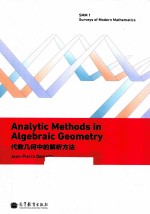

代数几何中的解析方法 英文版PDF电子书下载
- 电子书积分:10 积分如何计算积分?
- 作 者:(法)Jean-Pierre Demailly著
- 出 版 社:北京:高等教育出版社
- 出版年份:2010
- ISBN:9787040305319
- 页数:231 页
Introduction 1
Chapter 1. Preliminary Material:Cohomology,Currents 5
1.A. Dolbeault Cohomology and Sheaf Cohomology 5
1.B. Plurisubharmonic Functions 6
1.C. Positive Currents 9
Chapter 2.Lelong numbers and Intersection Theory 15
2.A. Multiplication of Currents and Monge-Ampère Operators 15
2.B. Lelong Numbers 18
Chapter 3.Hermitian Vector Bundles, Connections and Curvature. 25
Chapter 4.Bochner Technique and Vanishing Theorems 31
4.A. Laplace-Beltrami Operators and Hodge Theory 31
4.B. Serre Duality Theorem 32
4.C. Bochner-Kodaira-Nakano Identity on K?hler Manifolds 33
4.D. Vanishing Theorems 34
Chapter 5.L2 Estimates and Existence Theorems 37
5.A. Basic L2 Existence Theorems 37
5.B. Multiplier Ideal Sheaves and Nadel Vanishing Theorem 39
Chapter 6.Numerically Effective and Pseudo-effective Line Bundles 47
6.A. Pseudo-effective Line Bundles and Metrics with Minimal Singularities 47
6.B. Nef Line Bundles 49
6.C. Description of the Positive Cones 51
6.D. The Kawamata-Viehweg Vanishing Theorem 56
6.E. A Uniform Global Generation Property due to Y.T. Siu 58
Chapter 7.A Simple Algebraic Approach to Fujita's Conjecture 61
Chapter 8.Holomorphic Morse Inequalities 71
8.A. General Analytic Statement on Compact Complex Manifolds 71
8.B. Algebraic Counterparts of the Holomorphic Morse Inequalities 72
8.C. Asymptotic Cohomology Groups 74
8.D. Transcendental Asymptotic Cohomology Functions 78
Chapter 9.Effective Version of Matsusaka's Big Theorem 83
Chapter 10.Positivity Concepts for Vector Bundles 89
Chapter 11.Skoda's L2 Estimates for Surjective Bundle Morphisms 99
11.A. Surjectivity and Division Theorems 99
11.B. Applications to Local Algebra: the Brian?on-Skoda Theorem 105
Chapter 12.The Ohsawa-Takegoshi L2 Extension Theorem 111
12.A. The Basic a Priori Inequality 111
12.B. Abstract L2 Existence Theorem for Solutions of ?-Equations 112
12.C. The L2 Extension Theorem 114
12.D. Skoda's Division Theorem for Ideals of Holomorphic Functions 122
Chapter 13.Approximation of Closed Positive Currents by Analytic Cycles 127
13.A. Approximation of Plurisubharmonic Functions Via Bergman Kernels 127
13.B. Global Approximation of Closed(1,1)-currents on a Compact Complex Manifold 129
13.C. Global Approximation by Divisors 136
13.D. Singularity Exponents and log Canonical Thresholds 143
13.E. Hodge Conjecture and approximation of(p,p)- currents 148
Chapter 14.Subadditivity of Multiplier Ideals and Fujita's Approximate Zariski Decomposition 153
Chapter 15.Hard Lefschetz Theorem with Multiplier Ideal Sheaves 159
15.A. A Bundle Valued Hard Lefschetz Theorem 159
15.B. Equisingular Approximations of Quasi Plurisubharmonic Functions 160
15.C. A Bochner Type Inequality 166
15.D. Proof of Theorem 15.1 168
15.E. A Counterexample 170
Chapter 16.Invariance of Plurigenera of Projective Varieties 173
Chapter 17.Numerical Characterization of the K?hler Cone 177
17.A. Positive Classes in Intermediate(p,p)-bidegrees 177
17.B. Numerically Positive Classes of Type(1,1) 178
17.C. Deformations of Compact K?hler Manifolds 184
Chapter 18.Structure of the Pseudo-effective Cone and Mobile Intersection Theory 189
18.A. Classes of Mobile Curves and of Mobile(n-1,n-1)-currents 189
18.B. Zariski Decomposition and Mobile Intersections 192
18.C. The Orthogonality Estimate 199
18.D. Dual of the Pseudo-effective Cone 202
18.E. A Volume Formula for Algebraic(1,1)-classes on Projective Surfaces 205
Chapter 19.Super-canonical Metrics and Abundance 209
19.A. Construction of Super-canonical Metrics 209
19.B. Invariance of Plurigenera and Positivity of Curvature of Super-canonical Metrics 216
19.C. Tsuji's Strategy for Studying Abundance 217
Chapter 20.Siu's Analytic Approach and P?un's Non Vanishing Theorem 219
References 223
- 《中风偏瘫 脑萎缩 痴呆 最新治疗原则与方法》孙作东著 2004
- 《社会学与人类生活 社会问题解析 第11版》(美)James M. Henslin(詹姆斯·M. 汉斯林) 2019
- 《数字影视特效制作技法解析》王文瑞著 2019
- 《卓有成效的管理者 中英文双语版》(美)彼得·德鲁克许是祥译;那国毅审校 2019
- 《线性代数简明教程》刘国庆,赵剑,石玮编著 2019
- 《基于地质雷达信号波的土壤重金属污染探测方法研究》赵贵章 2019
- 《第一性原理方法及应用》李青坤著 2019
- 《数学物理方法与仿真 第3版》杨华军 2020
- 《Helmholtz方程的步进计算方法研究》李鹏著 2019
- 《2019国家医师资格考试用书 中医执业助理医师资格考试全真模拟试卷与解析 第3版》国家医师资格考试研究组 2019
- 《中风偏瘫 脑萎缩 痴呆 最新治疗原则与方法》孙作东著 2004
- 《水面舰艇编队作战运筹分析》谭安胜著 2009
- 《王蒙文集 新版 35 评点《红楼梦》 上》王蒙著 2020
- 《TED说话的力量 世界优秀演讲者的口才秘诀》(坦桑)阿卡什·P.卡里亚著 2019
- 《燕堂夜话》蒋忠和著 2019
- 《经久》静水边著 2019
- 《魔法销售台词》(美)埃尔默·惠勒著 2019
- 《微表情密码》(波)卡西亚·韦佐夫斯基,(波)帕特里克·韦佐夫斯基著 2019
- 《看书琐记与作文秘诀》鲁迅著 2019
- 《酒国》莫言著 2019
- 《全国高等中医药行业“十三五”创新教材 中医药学概论》翟华强 2019
- 《培智学校义务教育实验教科书教师教学用书 生活适应 二年级 上》人民教育出版社,课程教材研究所,特殊教育课程教材研究中心编著 2019
- 《指向核心素养 北京十一学校名师教学设计 英语 七年级 上 配人教版》周志英总主编 2019
- 《习近平总书记教育重要论述讲义》本书编写组 2020
- 《办好人民满意的教育 全国教育满意度调查报告》(中国)中国教育科学研究院 2019
- 《高等数学试题与详解》西安电子科技大学高等数学教学团队 2019
- 《北京生态环境保护》《北京环境保护丛书》编委会编著 2018
- 《教育学考研应试宝典》徐影主编 2019
- 《语文教育教学实践探索》陈德收 2018
- 《家庭音乐素养教育》刘畅 2018
